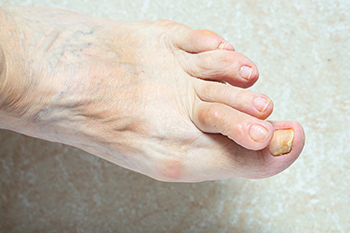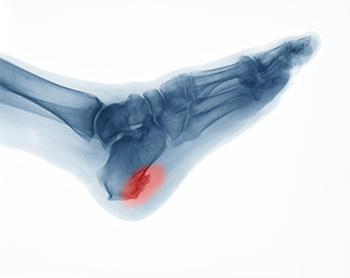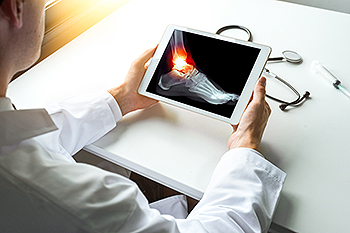Flint Office
1303 S. Linden Rd., Suite D
Flint, MI 48532

Hammertoe is a deformity in which one or more toes bend downward at the middle joint, causing a claw-like appearance. This condition can result from a variety of causes, including muscle imbalances, poor footwear choices, or inherited traits. In some cases, hammertoe is associated with underlying health conditions such as rheumatoid arthritis, or RA, where joint inflammation can lead to deformities in the toes. Charcot-Marie-Tooth disease, a genetic disorder that affects peripheral nerves, can also cause muscle weakness and imbalance, contributing to the development of hammertoe. Another common cause is an elongated second metatarsal bone, which can lead to abnormal pressure on the toes, causing them to bend. Symptoms of hammertoe include pain, difficulty walking, and corns or calluses forming on the affected toes. If you have developed a hammertoe, it is suggested that you consult a podiatrist who may guide you toward wearing corrective footwear, splints, or, in severe cases, surgery to realign the toe.
Hammertoes can be a painful condition to live with. For more information, contact one of our podiatrists of Community Podiatry Group. Our doctors will answer any of your foot- and ankle-related questions.
Hammertoe
Hammertoe is a foot deformity that occurs due to an imbalance in the muscles, tendons, or ligaments that normally hold the toe straight. It can be caused by the type of shoes you wear, your foot structure, trauma, and certain disease processes.
Symptoms
Risk Factors
Treatment
If you have hammertoe, you should change into a more comfortable shoe that provides enough room for your toes. Exercises such as picking up marbles may strengthen and stretch your toe muscles. Nevertheless, it is important to seek assistance from a podiatrist in order to determine the severity of your hammertoe and see which treatment option will work best for you.
If you have any questions, please feel free to contact our office located in Flint, MI . We offer the newest diagnostic and treatment technologies for all your foot care needs.

Heel spurs are bony growths that can develop on the underside of the heel bone, often associated with plantar fasciitis. These spurs form as a result of prolonged stress and inflammation in the plantar fascia, which connects the heel to the toes. Symptoms of heel spurs can vary, but they commonly include sharp pain in the heel, particularly during the first steps in the morning or after prolonged periods of sitting. The pain may subside with movement but can return after standing or walking for extended periods. Individuals may also experience tenderness and swelling surrounding the heel area. While heel spurs themselves may not always cause pain, the associated conditions can lead to significant discomfort. If you have heel pain, it may be caused by a heel spur, and it is suggested that you consult a podiatrist. This type of doctor can accurately diagnose and treat heel spurs.
Heel spurs can be incredibly painful and sometimes may make you unable to participate in physical activities. To get medical care for your heel spurs, contact one of our podiatrists from Community Podiatry Group. Our doctors will do everything possible to treat your condition.
Heels Spurs
Heel spurs are formed by calcium deposits on the back of the foot where the heel is. This can also be caused by small fragments of bone breaking off one section of the foot, attaching onto the back of the foot. Heel spurs can also be bone growth on the back of the foot and may grow in the direction of the arch of the foot.
Older individuals usually suffer from heel spurs and pain sometimes intensifies with age. One of the main condition's spurs are related to is plantar fasciitis.
Pain
The pain associated with spurs is often because of weight placed on the feet. When someone is walking, their entire weight is concentrated on the feet. Bone spurs then have the tendency to affect other bones and tissues around the foot. As the pain continues, the feet will become tender and sensitive over time.
Treatments
There are many ways to treat heel spurs. If one is suffering from heel spurs in conjunction with pain, there are several methods for healing. Medication, surgery, and herbal care are some options.
If you have any questions feel free to contact our office located in Flint, MI . We offer the latest in diagnostic and treatment technology to meet your needs.

Selecting the right running shoe is essential for enhancing performance and preventing injuries. First, consider the type of running you will be doing, whether it is road running, trail running, or track work, as each requires different features. The shoe should fit snugly but not painfully, allowing for about a thumb's width of space between the toe and the end of the shoe. Look for adequate support, especially if you have specific foot needs, such as pronation control. Flexibility is important for natural foot movement, while durability ensures that the shoe can withstand the rigors of regular use. Cushioning is vital for absorbing impact and providing comfort during longer runs. If you enjoy running and have endured a foot or ankle injury, it is suggested that you confer with a podiatrist who can offer you treatment solutions, and guide you on how to choose proper running shoes.
If you are a runner, wearing the right running shoe is essential. For more information, contact one of our podiatrists from Community Podiatry Group. Our doctors can provide the care you need to keep you pain-free and on your feet.
Choosing the Right Running Shoe for Your Foot Type
To increase performance and avoid the risk of injury, it is important to choose the right running shoe based on your foot type. The general design of running shoes revolves around pronation, which is how the ankle rolls from outside to inside when the foot strikes the ground.
If you have any questions please feel free to contact our office located in Flint, MI . We offer the newest diagnostic and treatment technologies for all your foot and ankle needs.

A trimalleolar fracture refers to a specific type of ankle injury that involves three distinct bony structures. It typically includes fractures of the lateral malleolus, medial malleolus, and the posterior malleolus of the tibia. This injury often occurs due to high-impact trauma, such as falling from a height or a severe twisting motion of the ankle. The resulting instability of the ankle joint can lead to significant pain, swelling, and difficulty in bearing weight. Diagnosis is typically confirmed through imaging studies like X-rays or CT scans, which reveal the extent of the fractures. Treatment often requires surgery to realign the fractured bones and stabilize the joint. If you have fractured your ankle, it is suggested that you consult a podiatrist who can accurately diagnose and treat this injury.
Broken ankles need immediate treatment. If you are seeking treatment, contact one of our podiatrists from Community Podiatry Group. Our doctors can provide the care you need to keep you pain-free and on your feet.
Broken Ankles
A broken ankle is experienced when a person fractures their tibia or fibula in the lower leg and ankle area. Both of these bones are attached at the bottom of the leg and combine to form what we know to be our ankle.
When a physician is referring to a break of the ankle, he or she is usually referring to a break in the area where the tibia and fibula are joined to create our ankle joint. Ankles are more prone to fractures because the ankle is an area that suffers a lot of pressure and stress. There are some obvious signs when a person experiences a fractured ankle, and the following symptoms may be present.
Symptoms of a Fractured Ankle
If you suspect an ankle fracture, it is recommended to seek treatment as soon as possible. The sooner you have your podiatrist diagnose the fracture, the quicker you’ll be on the way towards recovery.
If you have any questions, please feel free to contact our office located in Flint, MI . We offer the newest diagnostic and treatment technologies for all your foot care needs.